Related Research Articles
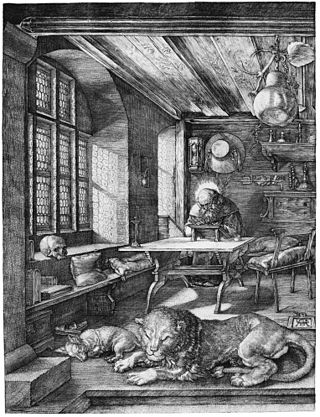
Engraving is the practice of incising a design onto a hard, usually flat surface by cutting grooves into it with a burin. The result may be a decorated object in itself, as when silver, gold, steel, or glass are engraved, or may provide an intaglio printing plate, of copper or another metal, for printing images on paper as prints or illustrations; these images are also called "engravings". Engraving is one of the oldest and most important techniques in printmaking.

Andrea Mantegna was an Italian painter, a student of Roman archeology, and son-in-law of Jacopo Bellini.

Martin Schongauer, also known as Martin Schön or Hübsch Martin by his contemporaries, was an Alsatian engraver and painter. He was the most important printmaker north of the Alps before Albrecht Dürer, a younger artist who collected his work. Schongauer is the first German painter to be a significant engraver, although he seems to have had the family background and training in goldsmithing which was usual for early engravers.

Robert Nanteuil was a French portrait artist: engraver, draughtsman and pastellist to the court of Louis XIV.

Hatching is an artistic technique used to create tonal or shading effects by drawing closely spaced parallel lines. When lines are placed at an angle to one another, it is called cross-hatching. Hatching is also sometimes used to encode colours in monochromatic representations of colour images, particularly in heraldry.
A Rake's Progress is a series of eight paintings by 18th-century English artist William Hogarth. The canvases were produced in 1732–1734, then engraved in 1734 and published in print form in 1735. The series shows the decline and fall of Tom Rakewell, the spendthrift son and heir of a rich merchant, who comes to London, wastes all his money on luxurious living, prostitution and gambling, and as a consequence is imprisoned in the Fleet Prison and ultimately Bethlem Hospital (Bedlam). The original paintings are in the collection of Sir John Soane's Museum in London, where they are normally on display for a short period each day.

Line art or line drawing is any image that consists of distinct straight lines or curves placed against a background, without gradations in shade (darkness) or hue (color) to represent two-dimensional or three-dimensional objects. Line art can use lines of different colors, although line art is usually monochromatic.

Master E. S. is an unidentified German engraver, goldsmith, and printmaker of the late Gothic period. He was the first major German artist of old master prints and was greatly copied and imitated. The name assigned to him by art historians, Master E. S., is derived from the monogram, E. S., which appears on eighteen of his prints. The title, Master, is used for unidentified artists who operated independently. He was probably the first printmaker to place his initials on his work.
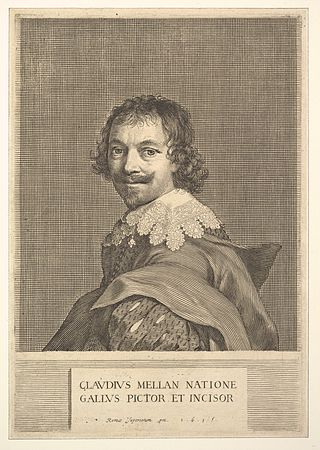
Claude Mellan was a French draughtsman, engraver, and painter.
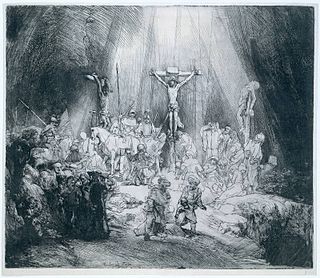
An old master print is a work of art produced by a printing process within the Western tradition. The term remains current in the art trade, and there is no easy alternative in English to distinguish the works of "fine art" produced in printmaking from the vast range of decorative, utilitarian and popular prints that grew rapidly alongside the artistic print from the 15th century onwards. Fifteenth-century prints are sufficiently rare that they are classed as old master prints even if they are of crude or merely workmanlike artistic quality. A date of about 1830 is usually taken as marking the end of the period whose prints are covered by this term.
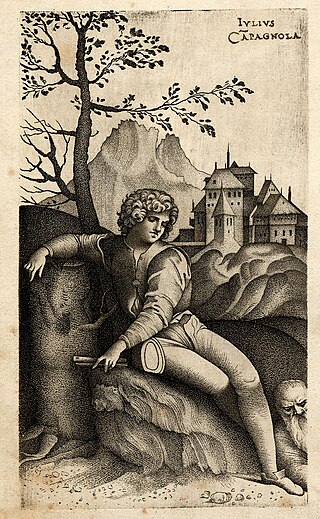
Giulio Campagnola was an Italian engraver and painter, whose few, rare, prints translated the rich Venetian Renaissance style of oil paintings of Giorgione and the early Titian into the medium of engraving; to further his exercises in gradations of tone, he also invented the stipple technique, where multitudes of tiny dots or dashes allow smooth graduations of tone in the essentially linear technique of engraving; variations on this discovery were to be of huge importance in future printmaking. He was the adoptive father of the artist Domenico Campagnola.

Jacopo de' Barbari, sometimes known or referred to as de'Barbari, de Barberi, de Barbari, Barbaro, Barberino, Barbarigo or Barberigo, was an Italian painter, printmaker and miniaturist with a highly individual style. He moved from Venice to Germany in 1500, thus becoming the first Italian Renaissance artist of stature to work in Northern Europe. His few surviving paintings include the first known example of trompe-l'œil since antiquity. His twenty-nine engravings and three very large woodcuts were also highly influential.

The Master of the Playing Cards was the first major master in the history of printmaking. He was a German engraver, and probably also a painter, active in southwestern Germany – probably in Alsace, from the 1430s to the 1450s, who has been called "the first personality in the history of engraving."
Jan Baptist Zangrius was a Flemish engraver, publisher, typographer and bookseller.

Hatching is a conventional system for monochrome denotation of heraldic armory, whereby the tinctures (colours) are represented by dots and lines. This technique is employed in cases where colours, for either aesthetic, practical or economic reasons are not reproduced – e.g. on surfaces such as woodcuts or engravings, seals and coins.
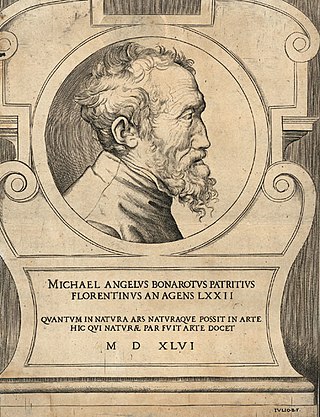
Giulio Bonasone was an Italian painter and engraver born in Bologna. He possibly studied painting under Lorenzo Sabbatini, and painted a Purgatory for the church of San Stefano, but all his paintings have been lost. He is better known as an engraver and is believed to have trained with Marcantonio Raimondi. He worked mainly in Mantua, Rome and Venice and with great success, producing etchings and engravings after the old masters and his own designs. He signed his plates B., I.B., Julio Bonaso, Julio Bonasone, Juli Bonasonis, Julio Bolognese Bonahso.

The Torment of Saint Anthony is attributed to Michelangelo, who painted a close copy of the famous engraving by Martin Schongauer when he was only 12 or 13 years old. Whether the painting is actually by Michelangelo is disputed. This painting is now in the Kimbell Art Museum in Fort Worth, Texas. It shows the common medieval subject, included in the Golden Legend and other sources, of Saint Anthony being assailed in the desert by demons, whose temptations he resisted; the Temptation of St Anthony is the more common name of the subject. But this composition apparently shows a later episode where St Anthony, normally flown about the desert supported by angels, was ambushed in mid-air by devils.

The visual arts are art forms such as painting, drawing, printmaking, sculpture, ceramics, photography, video, filmmaking, design, crafts, and architecture. Many artistic disciplines, such as performing arts, conceptual art, and textile arts, also involve aspects of the visual arts as well as arts of other types. Also included within the visual arts are the applied arts, such as industrial design, graphic design, fashion design, interior design, and decorative art.
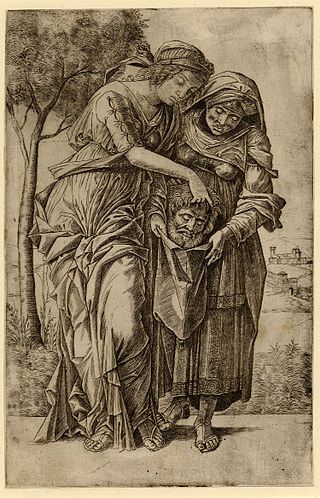
Girolamo Mocetto was an Italian Renaissance painter, engraver, and stained glass designer. He was heavily influenced by Domenico Morone, Giovanni Bellini, Bartolomeo Montagna, Cima da Conegliano, and especially Andrea Mantegna. He is most important as an engraver, and his engravings of the compositions of others are his most successful prints.

Great Passion is a 1497-1510 series of eleven woodcuts plus a frontispiece by Albrecht Dürer. Its title distinguishes it from his later Small Passion. One of the best surviving sets is now in the Albertina in Vienna.